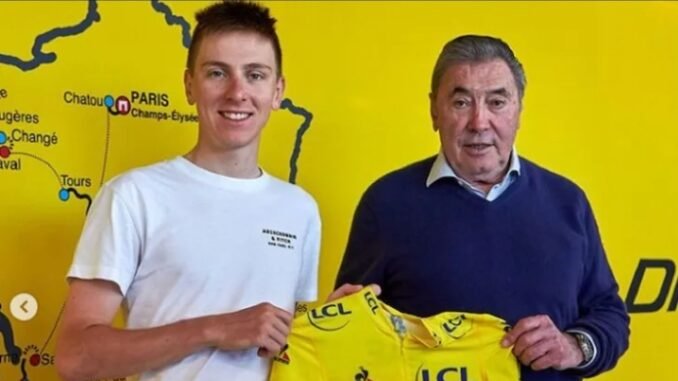
“It Would Take Four Legends to Surpass Eddy Merckx” — Axel Merckx Weighs In on Cycling’s GOAT Debate
In the ever-persistent debate over who is the greatest cyclist of all time, one name inevitably rises to the top — Eddy Merckx. Known as “The Cannibal” for his insatiable hunger for victory, the Belgian icon’s career tally of 525 professional wins, including five Tour de France titles, five Giro d’Italia crowns, a Vuelta a España, and a staggering array of one-day classics, remains unmatched more than four decades after his retirement.
Recently, Axel Merckx — himself a former professional and son of the legendary Eddy — offered an intriguing take on just how difficult it would be to eclipse his father’s legacy. Speaking to the Spanish sports outlet AS, Axel suggested that no single modern rider could replicate Eddy’s dominance across all terrains and formats.
Instead, he argued, “You would need to combine Tadej Pogačar, Mathieu van der Poel, Mark Cavendish, and Remco Evenepoel to come close to what my father achieved.”
Why Four Modern Stars Are Needed
Axel’s reasoning is rooted in the unique strengths of each rider.
-
Tadej Pogačar, the Slovenian phenom and four-time Tour de France champion, is perhaps the most complete modern stage racer. His ability to dominate in the mountains, time trials, and week-long stage races recalls elements of Eddy’s versatility. However, as Axel noted, even Pogačar doesn’t match his father’s one-day dominance.
-
Mathieu van der Poel, the Dutch powerhouse, is arguably the finest classics rider of his generation. His victories at Milan–San Remo, Paris–Roubaix, and the Tour of Flanders showcase an explosive skill set in one-day monuments that Pogačar only partially possesses.
-
Mark Cavendish, the Manx Missile, brings world-class sprinting ability to the mix. His record-tying 35 Tour de France stage wins and dominance in bunch sprints mirror a part of Merckx’s career many overlook — Eddy wasn’t just a climber or time trialist; he could also sprint with the best.
-
Remco Evenepoel, another Belgian prodigy, offers raw power in time trials and long solo breakaways. His wins in the Vuelta a España, Liège–Bastogne–Liège, and World Championships road race highlight an aggressive, fearless racing style reminiscent of a young Merckx.
Together, these four riders represent the spectrum of cycling excellence — but individually, none can match the all-encompassing dominance Eddy displayed during his prime.
The Unmatched Versatility of Eddy Merckx
Merckx’s career was defined not only by victories but also by his relentless calendar. He regularly raced over 150 days per season, winning across grand tours, classics, track events, and even smaller regional races. In today’s era, where riders focus on select peaks in the season, such a year-round winning mentality is nearly impossible to replicate.
As Axel pointed out, modern cycling is more specialized than in his father’s time. Nutrition, training science, and team tactics have improved, but so has the level of competition. Riders now target specific goals — the Tour, the Classics, or World Championships — whereas Merckx seemed to target everything.
A Respectful Comparison
While Axel’s statement might be interpreted as a slight toward modern champions, his tone was far from dismissive. He expressed admiration for Pogačar’s stage race dominance, Van der Poel’s one-day brilliance, Cavendish’s sprinting prowess, and Evenepoel’s all-round explosiveness. His point was not that these riders are lacking, but that Merckx’s combination of skills, endurance, and consistency remains unparalleled.
The GOAT Debate Lives On
As long as the sport exists, fans will compare modern stars to the legends of the past. Pogačar continues to build an extraordinary palmarès, Van der Poel dazzles in the classics, Cavendish cements his sprinting legacy, and Evenepoel’s career is still in its early chapters.
But if Axel Merckx is right, dethroning “The Cannibal” may require more than just one exceptional rider — it might take four of today’s very best, rolled into a single, almost mythical figure.
Leave a Reply